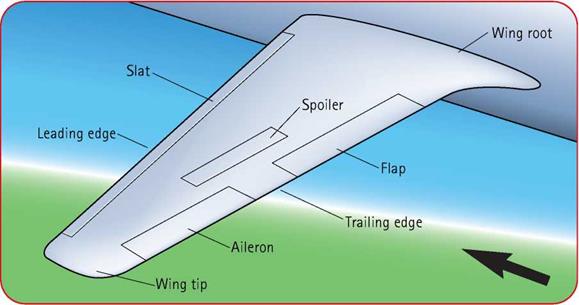Boosting Lift
An airplane needs big wings to produce large amounts of lift when it is flying slowly during takeoff and landing. Big wings that produce a lot of lift, however, also produce a lot of drag. Excessive
drag makes the wings inefficient when the plane is cruising at high speed, because the engines have to burn more fuel to overcome it.
Designers solve this problem by creating the best wings for high-speed cruising but changing their size and shape for takeoff and landing. As an airliner prepares for takeoff or landing, flaps slide out from the trailing edges of its wings, and strips called slats slide out from the leading edges. Flaps and slats are called high-lift devices because they produce extra lift. Flaps produce more lift by making a wing bigger and more curved. When slats are extended, they make the leading edge of a wing more curved. This shape enables the wing to be tilted to a greater angle of attack without stalling. The higher angle of attack produces extra lift.
The simplest flaps hinge downward from the wing’s trailing edge. Fowler flaps slide backward and then tilt down.
——————————————————————- £——————————————————————
THE ANATOMY OF AN AIRPLANE WING
The front edge of a wing also is called its leading edge, and the back edge is the trailing edge. The measurement from the leading edge straight back to the trailing edge is the wing’s chord. The length from one wingtip to the other is the wingspan. The curvature of the top and bottom of a wing is called its camber. The part of a wing where it joins a plane’s fuselage is the wing root. A wing’s aspect ratio is a measure of how long and slender it is. A wing that has a high aspect ratio (long and slender) causes less drag, so it is good for gliding. Wings usually tilt up from an airplane’s body toward the wingtips, forming a shallow V shape. The angle of this tilt is called the dihedral, and the wing’s dihedral makes an airplane more stable.
![]()
|

They increase the size and curve, or camber, of a wing. Flaps are nearly always on a wing’s trailing edge, but Krueger flaps are on the leading edge.
The increased curve in the wing shape produced by flaps may cause a wing to stall and lose lift if the smooth airflow over the wing breaks away from the drooping flaps.
When a slotted flap slides out, a gap opens up between the flap and the rest of the wing. Air from below the wing comes up through the slot and flows over the top of the flap. This extra airflow helps to stop the wing from stalling. There are also slotted slats. Air coming up through the slot from below flows over the top of the wing and
enables the wing to work safely at a higher angle of attack without stalling. A blown flap is a device that blows air from the engine over the flaps. The extra airflow produces more lift and delays stalling even more.










